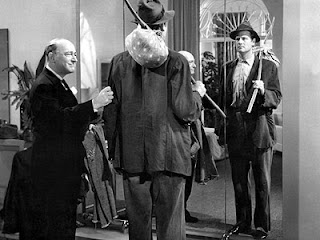Werth: Hi there, Wise! I see you're chipper today.
Werth: I'm assuming that Adam Sandler is not represented.
Wise: Unfortunately not, but the festival kicks off with the detective comedy classic The Thin Man (1934). Adapted from the novel by Dashiell Hammett, the film adds a madcap gloss to the book's gumshoe aesthetic. William Powell and Myran Loy play Nick and Nora Charles—he a retired, tippling detective and she a glamorous heiress—who get pulled into the case of missing inventor Clyde Wynant (Edward Ellis) whose mistress turns up dead.
Werth: Because nothing is funnier than a dimestore blonde with a bullet in her back.
Wise: The film is a strange—but delightful—hybrid of film noir and screwball comedy, filled with street toughs lurking in shadows, loud-mouthed dames, but leavened by the amazing chemistry between Powell and Loy. Powell's performance as cocktail guzzling Nick is loaded with charm as he nimbly displays a sparkling verbal acuity as well as a liver that just won't quit.
Werth: How he shoots balloons off a Christmas tree after five martinis I'll never know.
Wise: But just as spectacular is Loy's effervescent performance as Nora. Taking what could have been yet another dithering society girl, Loy gives Nora beauty and brains and shows she knows how to use both.
 Her devotion to Nick makes him sexy, and just as Ginger Rogers brought out Fred Astaire's carnality, Loy makes a funny-looking man with an odd talent into an object of desire.
Her devotion to Nick makes him sexy, and just as Ginger Rogers brought out Fred Astaire's carnality, Loy makes a funny-looking man with an odd talent into an object of desire.
Werth: She should have been paired up with Peter Lorre.
Wise: Of course, I have to mention the other great performance in the film: Skippy as the Charles' wire-haired fox terrier Asta. Instead of remaining a canine accessory, Asta ferrets out both clues and comic relief, plus sparked a nationwide frenzy for the breed. Director W.S. Van Dyke gives Asta some of the best screen moments, which actually seems to point to Van Dyke's strength as a director.
Known around the MGM lot as "one take Woody," he shot The Thin Man in about fourteen days, and while he dispenses with some of the visual flourishes that might have marked him an auteur, his strategy seems to have been laying a solid groundwork, then getting out of the way while his on-screen talent made fireworks of their own.
Werth: I think I'll go to BAM to take in one of my favorite laugh-fests, Preston Sturges' classic, Sullivan's Travels (1941).
Wise: You mentioned that flick once before in our posting about silver screen racism.
Werth: I did, because one particular scene does smack of racist stereotypes, but interestingly enough as the movie progresses, Sturges seems to comment on these sterotypes as he explores the difference and interdependence between comedy and drama.
John L. Sullivan (Joel McCrea) is a successful director of frothy comedies like Ants in Your Plants and Hey, Hey in the Hayloft. But he has tired of making the world laugh and wants to instead address the serious issues of poverty and homelessness in America in a new film called O Brother, Where Art Thou?
Wise: Talk about being stuck in development until George Clooney and the Coen brothers took it on.
Werth: But after an argument with his producers, Sullivan realizes that he doesn't have any idea what it means to be poor or in trouble. So he decides to dress in the era's hobo-chic and ride the rails to connect with the common man. Sullivan's producers balk at the idea of their big money-making vehicle driving off the road, so they have him followed by a crew of keepers, doctors and reporters in a "land-yacht."
In the midst of trying to shake this stellar group of character actors (including Sturges favorite William Demarest), Sullivan meets a failed starlet (ethereal and pregnant at the time Veronica Lake) who joins in on his adventure to help him experience life on the wrong side of the tracks. The film has all the Sturges comedy hallmarks of pratfalls, bullet-fast dialogue and complex physical comedy scenes—like when the inside of the land-yacht turns into a funhouse as the bus drives off-road chasing Sullivan in a nitrus-powered kiddie car.
Wise: I guess Lucy's pratfalls in The Long, Long Trailer (1953) weren't so original.
Werth: But mid-way, the film takes a fascinating turn. As Sullivan and his partner walk into trainyards, shanty-towns, and soup kitchens, Sturges shows an assemblage of disturbingly real faces—worn, grizzled, forgotten, White, Black, and Brown. As Sullivan is shanghaied, mistaken for dead and put on a Southern chaingang, the movie leaves the realm of comedy entirely, making us realize that maybe the tumbles into swimming pools, wisecracks and flying cake batter aren't so important. But to Sturges, they are.
The legendary scene of the prisoners watching a Mickey and Pluto cartoon in a Black church is a touching (albeit obvious) depiction of the power of comedy to elevate our spirits, if only for a moment. The film asserts that comedy lifts humanity out of the troubles of life and that it's better to go to a movie to laugh than to cry. But it's not that simple.
Sturges uses drama in Sullivan's Travels to help us arrive at his theme of comedy conquers all, making drama and comedy an inseparable yin and yang of the Hollywood movie and our lives.
Wise: Which reminds me of another inseparable pairing: Film Gab and Next Week.
Werth: Hilarious! And don't forget to catch a little comedy genius at BAM.














No comments:
Post a Comment